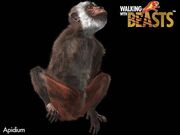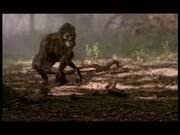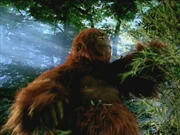
Apidium. (Official image.)
Catarrhini is one of the two subdivisions of the higher primates (the other being the New World monkeys or platyrrhines). It contains the Old World monkeys and the apes; the latter of which are in turn further divided into the lesser apes or gibbons and the great apes, consisting of the orangutans, gorillas, chimpanzees, bonobos, and humans. They are all native to Africa and Asia. Members of this parvorder are called catarrhines.
Facts[]
As a group, monkeys have split away from the more primitive prosimians (i.e. Godinotia) in the during the Eocene, during which (about 45 MYA) they split into two groups - the New World monkeys and the Old World.
35 MYA, during the late Eocene, the apes and the Old World monkeys parted ways. Around 20 MYA, the evolutionary branch leading to the modern orangutan split off, and 10 MYA - the gorilla's. The separation between human and chimpanzee ancestors occurred between 7 and 9 MYA, during the Miocene.
In Walking with... Series[]
Walking with Beasts[]
Whale Killer[]
This episode featured a group of Apidium, the only species of prehistoric Old World monkey featured in the Walking with... series. Unlike the Godinotia, featured in the first episode of this series, Apidium was both duirnal and social and was similar to modern monkeys in many ways.
Next of Kin[]
This episode was centered around a family of Australopithecus, and their survival in the Pliocene epoch. At first driven out of their home territory by a rival clan, they were threatened by many dangers, including an angry Deinotherium and a predatory Dinofelis. At the end of the episode, however, the Australopithecus turn the tables on the predator, using teamwork to drive it away from their territory.

Walking with Cavemen[]
First Ancestors[]
This episode is also centered on Australopithecus. It depicts them as apes, but apes that had evolved walking on two legs, bipedality, which was also depicted in WWB. This made them better adapted to living on solid ground and enabled them to survive and evolve into new species, as the climate became dryer and open spaces (the savannas) spread.
Blood Brothers[]
This episode featured one of the last non-hominid apes - Paranthropus boisei. Unlike the first human ancestors, it was a specialized animal, one that was unable to adapt, as climate changed at the end of the episode.
Savage Family[]
This episode featured Gigantopithecus, the biggest primate to have ever walked the Earth. It scared away a group of Homo erectus through its sheer size.

